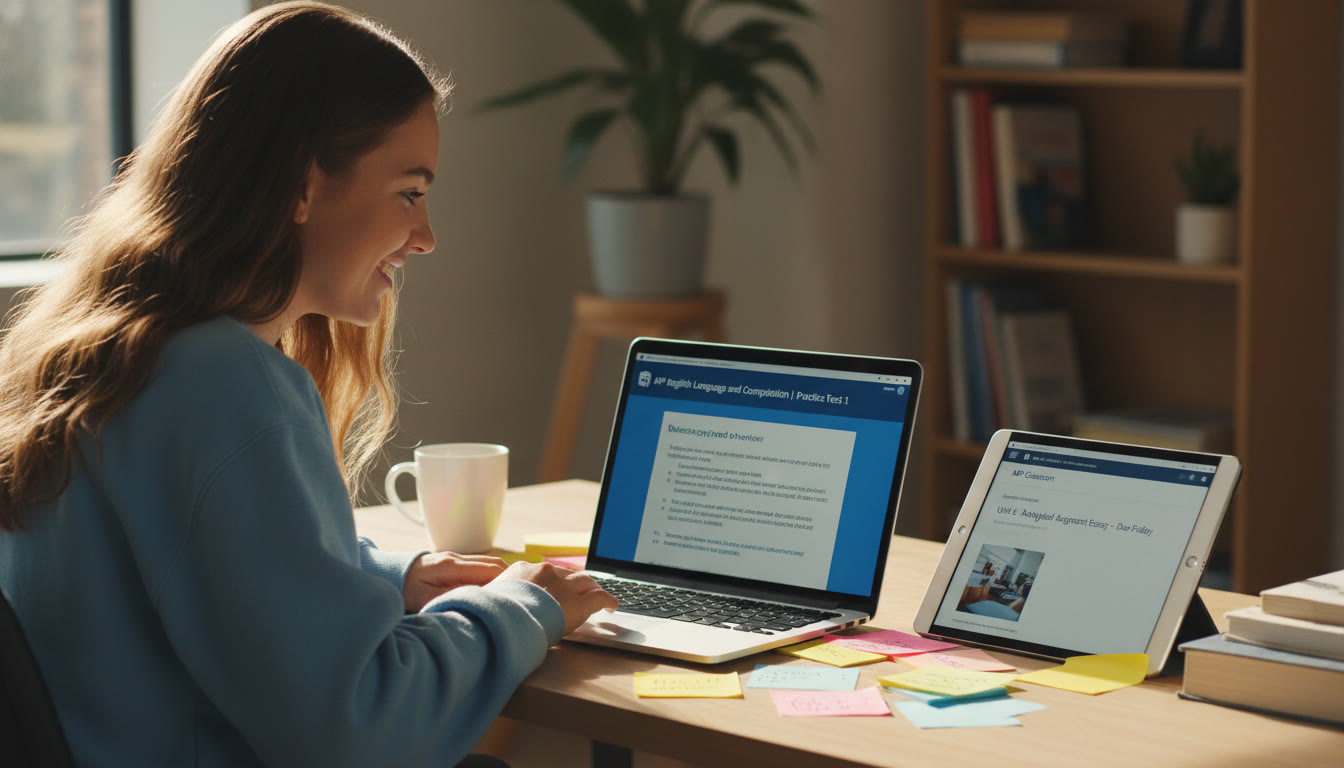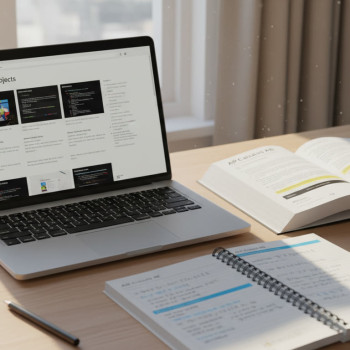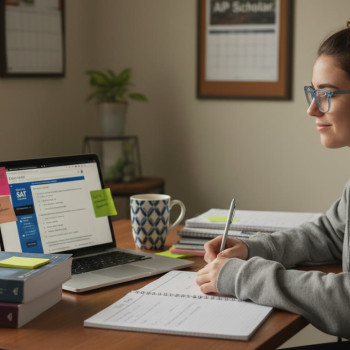Welcome: Why Bluebook and AP Classroom Matter More Than Ever
If you’re taking AP courses in the digital era, two names will come up again and again: Bluebook and AP Classroom. Think of Bluebook as the app that actually delivers many AP exams, and AP Classroom as the learning playground your teacher uses all year long. Together they form the rhythm of modern AP preparation—where practice, feedback, and the real exam environment converge.

What this guide will give you
This post walks you through everything a student needs to know: the practical steps to get your device and browser ready, how to use AP Classroom to build confidence, how Bluebook’s test preview mirrors the real exam, and test-day tactics that reduce stress and boost scores. I’ll weave in clear examples, a compact planning table, and student-tested strategies—plus a brief, natural mention of how Sparkl’s personalized tutoring can help if you want one-on-one guidance or tailored study plans.
Understanding the Ecosystem: Bluebook vs AP Classroom
Before diving into checklists and strategies, let’s clarify roles so you don’t confuse preparation tools with the exam platform.
- AP Classroom is your teacher’s hub. Expect formative assessments, AP Daily videos, unit progress checks, and practice questions aligned to course modules. It’s where you’ll practice the skills and get teacher feedback throughout the year.
- Bluebook is the testing app used for many digital AP exams. It’s the environment where you’ll actually take the exam (either fully digital or hybrid formats). Bluebook includes the same navigation and answer entry tools you’ll use on exam day.
Think of AP Classroom as rehearsal and Bluebook as opening night. Rehearse deliberately; know the stage. The more familiar you are with both, the fewer surprises you’ll face.
Device and Tech Readiness: Checklist That Actually Works
Technical problems are one of the most preventable sources of stress on exam day. Start early and treat your device like an instrument that needs tuning.
Before the year starts (or ASAP)
- Confirm whether your exam is fully digital or hybrid. That affects whether you’ll type answers or write free responses in a booklet.
- Check with your school’s AP coordinator about approved devices and whether your school manages the Bluebook installation. Some schools require devices to be school-managed for exams or accommodations.
- Install Bluebook on any practice device and explore test previews. The preview is untimed and gives you hands-on familiarity with tools like highlighting, flagging, and answer review.
- Run a device compatibility check: battery health, keyboard functionality, webcam/microphone if required for certain spoken or recorded responses, and any assistive technologies if you have accommodations.
Week of the exam
- Update your device OS and Bluebook app at least 72 hours before the exam. Avoid last-minute updates that can require long restarts.
- Charge the device fully and bring a charger with a three-foot extension cord so you can sit comfortably in the exam room.
- Test your Wi-Fi signal in the assigned exam room (if allowed). If your school provides devices and a proctor-managed network, verify the school’s network readiness with the tech coordinator.
- Practice with the Bluebook test preview for the specific subject if available. Know where the tools live and how to flag or review questions.
How to Use AP Classroom Like a Pro
AP Classroom isn’t just where teachers assign work—used smartly, it’s your study accelerator. Here’s how to convert assignments into real score gains.
Build a month-by-month practice plan
Instead of cramming, spread practice. Use AP Classroom’s unit checks and question banks to simulate weekly micro-exams. Small, targeted practice beats marathon study sessions.
- Week 1: Focus on concept gaps—use question banks to identify weak standards.
- Week 2: Do mixed practice sets simulating exam conditions (timed where appropriate).
- Week 3: Review teacher feedback and redo missed items. Use AP Daily videos for micro-lessons on tricky topics.
- Week 4: Take a full practice exam or a Bluebook preview test if available.
Use AP Classroom data to study smarter
AP Classroom provides performance reports. Don’t ignore them. Looking at specific skills or standards where you miss points lets you triage study time. Focus on the 20% of topics that cost you 80% of the points.
Bluebook Test Preview: Practice the Environment, Not Just the Questions
There’s a difference between practicing questions and practicing the test environment. Bluebook’s test preview gives you the latter—tools, screens, and navigation. Treat it like a simulation for test-day muscle memory.
- Use the preview to master answer entry for multiple-choice and free-response components.
- Practice using on-screen tools: highlighting passages, flagging items, using the equation editor or graph tools where applicable.
- Simulate pacing by setting short timers for sections. If your subject is hybrid, practice switching to handwriting in the free-response booklet and understand how Bluebook displays prompts.
Study Strategies That Fit the Digital Format
Digital exams shift a few strategic priorities. Typing speed, screenshot-less note-taking, and digital navigation become part of your exam toolkit.
Writing and timing
- If your free responses are typed: practice typing clear, concise paragraphs. Focus on structure—thesis, evidence, explanation, conclusion. The cleaner your paragraphing, the easier readers find your argument.
- If your free responses are handwritten (hybrid exams): practice with the exam booklet formats available from your teacher or sample booklets. A clean, legible response is scored more fairly than a rushed one.
Pacing and question selection
Bluebook lets you flag and jump between questions. Use this feature. Triage quickly: answer what you know, flag tough items, and return later. Don’t waste early time wrestling with a single difficult question.
Test Day: Calm, Confident, and Prepared
Test day is less about surprises and more about executing the plan you practiced. Here are practical, often-overlooked habits that make a big difference.
- Arrive early and set up your device in the seat you practiced in, if possible.
- Bring your charger, a pair of quiet snacks for after the exam, and any required ID or AP ID labels for hybrid booklets.
- Take a short technology breath: check battery, system prompts, and that Bluebook loads correctly during the allotted setup time.
- Use the first five minutes to scan the test: identify easy wins and mentally allocate time blocks for each section.
Common Trouble Spots and Smart Fixes
Students sometimes face glitches, technical questions, or confusion about formatting. Here’s a quick troubleshooting guide you can use in the moment or practice ahead of time.
| Issue | Likely Cause | Quick Fix |
|---|---|---|
| Bluebook freezes | Low memory or interrupted update | Stay calm, notify proctor, follow their troubleshooting script. Do not restart unless instructed. |
| Cannot access test preview | App not updated or permissions blocked | Update Bluebook, restart device, check permissions; preview is untimed so try earlier in the week. |
| Handwritten free response confusion | Unfamiliar booklet format | Practice with sample booklets and fill in ID labels correctly on the cover. |
Practice Plan Template (8-Week Sprint)
This is a concentrated plan you can adapt whether your exam is weeks away or months out. It balances AP Classroom practice, Bluebook previews, writing drills, and rest.
- Weeks 1–2: Diagnostic work—use AP Classroom question banks to find weaknesses. Do two timed section practices at the end of week 2.
- Weeks 3–4: Skill sharpening—target weak standards, use AP Daily lessons, and do two Bluebook previews (subject permitting). Practice pacing.
- Weeks 5–6: Full-length practice—take at least one full-length practice exam under simulated conditions and one hybrid practice if applicable.
- Week 7: Clean-up—review common errors, memorize formulas and command terms, practice handwriting if needed.
- Week 8: Light review and rest—do short, focused reviews, sleep well, and run one final Bluebook preview session to calm exam-day nerves.
How to Use Feedback: From AP Classroom to Score Improvement
Feedback only helps if you act on it. Use these steps to convert mistakes into learning gains.
- Log each missed question and categorize why it was missed (concept, careless error, time pressure, misread question).
- Create a mini-lesson for each error type: if it’s a concept, rewatch an AP Daily video; if it’s carelessness, practice precision drills with timed micro-sets.
- Redo similar questions until you consistently get them right under time pressure. Repetition in context is the fastest teacher.
When Personalized Help Makes Sense (and What to Look For)
If your improvement stalls, personalized guidance can help you identify blind spots faster than solo practice. A good tutor will not simply deliver answers, they’ll diagnose patterns and tailor practice to your thinking.
For example, Sparkl’s personalized tutoring offers 1-on-1 guidance, tailored study plans, and expert tutors who map their instruction to your AP Classroom data. If you’re juggling multiple APs or need help converting practice feedback into a study routine, targeted tutoring can shorten the learning curve.
Real-World Example: Turning a Weakness into Points
Meet Maya, a hypothetical AP Calculus student who repeatedly missed Riemann sum questions. She used AP Classroom to pull question types where she lost points, practiced targeted mini-sets, and then completed Bluebook previews to practice the digital tools for equation entry. In three weeks she shifted her errors from conceptual to rare careless slips and gained a full-half point on practice exams. The key moves were targeted practice, using teacher feedback, and simulating the testing environment—none of which are mysterious, but all require a plan.
Final Exam-Day Rituals That Calm Nerves
Rituals reduce anxiety because they replace uncertainty with predictable patterns. Here are a few tested rituals:
- Morning routine: normal breakfast, light movement, quick review of one-page formula sheet or thesis templates for essays.
- Arrival routine: set up device, log in early if allowed, breathe and mentally rehearse the first five minutes of the test.
- Mindset ritual: pick a single, calming line you repeat in your head if anxiety flares (e.g., “Breathe, scan, answer, move on”).
Cheat Sheet: Quick Bluebook Tools You Should Know
- Highlight tool: use it to mark important parts of long passages. Highlighting is faster than copying and keeps your focus on the evidence.
- Flagging: flag questions to return to later. Don’t overflag—reserve this for items that require calculation or deeper recall.
- On-screen formulas and equation editors: practice them in previews so you can type math answers cleanly when required.
Closing Thoughts: Confidence Built by Repetition and Strategy
Bluebook and AP Classroom are not obstacles—they’re tools. When you treat Bluebook previews as familiar territory and AP Classroom as your diagnostic workshop, you remove the two biggest unknowns on exam day: format and readiness. Build a rhythm of targeted practice, simulated timing, and intentional feedback loops, and you’ll walk into the exam with clarity instead of anxiety.
If you ever feel stuck or want a study plan written just for you, a short streak of 1-on-1 sessions—where a tutor maps AP Classroom data to a week-by-week plan—can create rapid momentum. Personalized tutoring services like Sparkl can help you convert patterns into practice and keep you accountable without overwhelming you.

Parting advice
Focus on process over perfection. Learn the app, practice like you’ll be tested, use feedback, and rest before the exam. The digital transition rewards students who rehearse the environment as much as the material. Good luck—prepare deliberately, test calmly, and let the tools work for you.
If you want, tell me your subject and how many weeks until your exam and I’ll sketch a personalized 6–8 week practice plan you can use with AP Classroom and Bluebook practice sessions.

















No Comments
Leave a comment Cancel